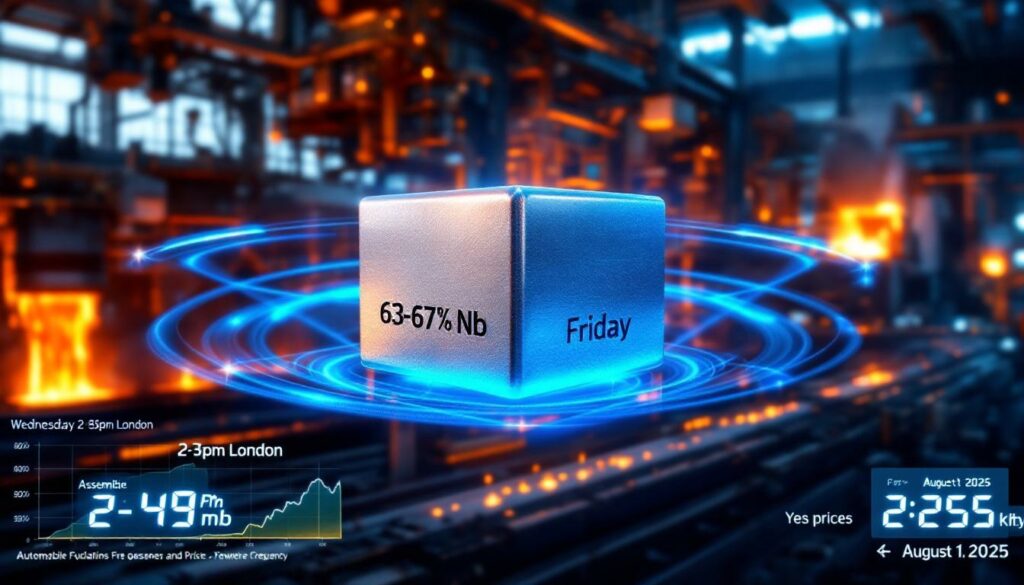Understanding Ferro-Niobium Price Assessment Changes: What Market Participants Need to Know
The ferro-niobium market is undergoing a significant change with Fastmarkets implementing an amendment to frequency of ferro-niobium price assessment. This comprehensive guide explains what these changes mean for market participants, why they're happening, and how to adapt to the new assessment schedule.
What is Ferro-Niobium and Why Does Its Price Assessment Matter?
Ferro-niobium is a critical ferro-alloy used primarily in the production of high-strength, low-alloy (HSLA) steels. Composed of 63-67% niobium, this strategic material significantly enhances steel properties, providing increased strength, corrosion resistance, and weldability at relatively low addition rates.
The Strategic Importance of Ferro-Niobium
Ferro-niobium serves as an essential component in multiple high-value industries:
- Automotive manufacturing: Used in chassis components, structural reinforcements, and exhaust systems where weight reduction without compromising strength is critical
- Construction sector: Incorporated into structural steels for buildings, bridges, and infrastructure projects requiring enhanced durability
- Aerospace applications: Essential for high-performance alloys in aircraft components where weight-to-strength ratio is paramount
- Energy sector: Utilized in pipelines, power plants, and offshore structures facing extreme conditions
The addition of just 0.025-0.1% niobium can increase steel strength by up to 30%, making it one of the most efficient alloying elements available to metallurgists. This efficiency explains why precise price forecast insights are crucial for both suppliers and consumers in negotiating contracts.
Industry insight: The global ferro-niobium market is highly concentrated, with Brazil accounting for approximately 90% of worldwide production. This supply concentration makes price assessment accuracy particularly important for market stability.
The Evolution of Ferro-Niobium Market Assessment
Price assessments for ferro-niobium have historically been conducted on a weekly basis, which aligned with traditional trading patterns in specialty metals markets. However, several factors have driven the need for more frequent assessments:
- Increased spot market transactions outside the traditional weekly cycle
- Growing market volatility requiring more timely price signals
- Enhanced market transparency demands from both buyers and sellers
- Digital trading platforms facilitating more frequent transactions
A weekly assessment schedule can create information gaps, particularly during periods of significant market movement. When prices shift rapidly, market participants relying on weekly assessments may find themselves operating with outdated information for several days.
What Changes Are Being Implemented to the Ferro-Niobium Price Assessment?
Fastmarkets has announced a significant amendment to the frequency of ferro-niobium price assessment, moving from a weekly to a twice-weekly schedule. This change aims to better capture market dynamics in an increasingly liquid trading environment.
Key Modifications to the Assessment Schedule
The specific changes to the ferro-niobium price assessment include:
- New assessment frequency: Twice weekly (Wednesdays and Fridays) vs. previous weekly (Wednesdays only)
- Implementation date: Friday, August 1, 2025
- Publication timing: 2-3pm London time on both assessment days
- Price code: MB-FN-0001 remains unchanged
- Complete specification: "Ferro-niobium, 63-67%, delivered consumer works, dp Europe, $ per kg Nb"
This change represents a significant enhancement in market information availability while maintaining all existing quality specifications and assessment parameters.
Technical Specifications Maintained in the Assessment
The technical specifications for the assessed material remain unchanged:
| Parameter | Specification |
|---|---|
| Physical form | 10-50mm lump size |
| Niobium content | 63-67% |
| Carbon (C) | 0.2% max |
| Silicon (Si) | 3.0% max |
| Aluminum (Al) | 1-2% |
| Sulfur (S) | 0.15% max |
| Phosphorus (P) | 0.20% max |
| Tantalum (Ta) | 0.5% max |
| Minimum quantity | 5-tonne lots |
| Packaging | 250kg drums or one-tonne big bags |
| Delivery terms | Delivered consumer works, Europe |
| Payment terms | Cash, with other terms normalized |
| Unit | USD per kg Nb |
These specifications ensure that the price assessment continues to reflect the industry-standard material quality that market participants rely on for their contracts and negotiations.
Why Is Fastmarkets Increasing the Assessment Frequency?
The decision to amend the frequency of ferro-niobium price assessment stems from observable changes in market dynamics and feedback from industry participants.
Market-Driven Rationale for the Change
According to Fastmarkets' pricing notice published on July 31, 2025: "This more frequent price assessment will help Fastmarkets better capture spot dynamics amid rising liquidity and market activity." This statement highlights several key factors driving the change:
- Increased market liquidity: More transactions are occurring between traditional assessment points
- Enhanced price discovery: More frequent assessments reduce information gaps
- Market evolution: Trading patterns have shifted toward more regular transactions
- Stakeholder input: Industry participants have requested more timely price information
The ferro-niobium market has evolved beyond the traditional pattern of concentrating transactions around a single weekly assessment point. As spot market activity increases, a twice-weekly assessment schedule provides a more accurate reflection of actual market conditions.
Benefits for Market Participants
The amended assessment frequency offers several advantages for different market stakeholders:
- For traders: More accurate price discovery for spot transactions and better timing of market entries/exits
- For producers: Enhanced ability to track real-time market trends and adjust production strategies
- For consumers: More current pricing information for procurement planning and contract negotiations
- For financial participants: Additional data points for modeling and forecasting price trends
More frequent assessments create a virtuous cycle where better price information leads to increased market confidence, potentially stimulating additional transaction activity and further improving market liquidity.
How Will the New Assessment Schedule Impact Market Dynamics?
The transition to twice-weekly assessments represents more than just an additional data point; it has the potential to influence how participants interact with the market.
Implications for Traders and Consumers
Market participants should anticipate several operational and strategic adjustments:
- Contract structures: Long-term contracts referencing the ferro-niobium price may need updating to specify which assessment day (Wednesday or Friday) serves as the reference point
- Trading patterns: Transaction timing may evolve to capture advantageous pricing around both assessment days
- Risk management: Enhanced price visibility allows for more nuanced hedging strategies
- Market psychology: Traders may develop new strategies based on price movements between Wednesday and Friday assessments
For consumers with flexible procurement schedules, the additional assessment provides an opportunity to time purchases more strategically. Traders may develop new strategies targeting price differentials between the two weekly assessments.
Data Quality and Market Representation
Maintaining robust data quality with increased assessment frequency requires careful consideration:
- Data collection processes: Fastmarkets will continue to gather information from a diverse range of market sources
- Normalization methodologies: Consistent application of normalization for non-standard terms
- Statistical validity: Ensuring each assessment is based on sufficient market inputs
- Transparency protocols: Maintaining clear documentation of assessment methodologies
The payment terms normalization process is particularly important, as Fastmarkets standardizes to cash terms while normalizing other payment conditions to maintain comparability across reported transactions.
How Does This Change Fit into Broader Market Assessment Trends?
The amendment to the ferro-niobium price assessment frequency aligns with broader trends in commodity price reporting.
Industry Benchmarking and Best Practices
This change reflects several industry-wide developments:
- Increased assessment frequencies: Many specialty metals markets are moving toward more frequent assessments
- Digital transformation: Technology platforms enabling more timely data collection and analysis
- Transparency initiatives: Growing emphasis on price discovery visibility
- Market fragmentation: Adaptation to more diverse trading patterns and regional variations
The ferro-niobium assessment is part of Fastmarkets' Ores and Alloys Physicals Package, indicating its integration into a broader ecosystem of related metal assessments used throughout the steel value chain.
Technology and Data Infrastructure Considerations
The shift to twice-weekly assessments is supported by evolving data infrastructure:
- Digital submission platforms: Enhanced systems for market participants to submit pricing information
- Data verification protocols: Automated and human validation processes to ensure data integrity
- Distribution channels: Multi-platform availability of assessment results
- Analytical tools: Resources for market participants to interpret the increased data flow
These technological foundations ensure that the additional assessment point is supported by robust data collection and distribution mechanisms.
What Should Market Participants Do in Response to These Changes?
Adapting to the new assessment schedule requires proactive measures from market participants.
Practical Steps for Adaptation
Market stakeholders should consider the following actions:
- Review existing contracts that reference the ferro-niobium price assessment
- Update internal systems to accommodate the additional weekly data point
- Adjust trading strategies to leverage the new assessment schedule
- Reconsider risk management approaches based on more frequent price signals
- Evaluate procurement timing to potentially benefit from the additional assessment day
For organizations with automated systems that ingest price assessment data, technical updates may be required to properly handle the increased frequency.
Feedback Mechanisms and Market Engagement
Fastmarkets explicitly encourages market participation in the assessment process:
"To provide feedback on this price, or if you would like to provide price information by becoming a data submitter to this price, please contact Zdravko Cherkezov by email at: pricing@fastmarkets.com. Please add the subject heading 'FAO: Zdravko Cherkezov, re: ferro-niobium'."
Active engagement with the price reporting agency benefits all market participants by enhancing:
- Assessment accuracy: More data points lead to more representative prices
- Market transparency: Broader participation improves overall market visibility
- Methodological refinement: Feedback helps shape future assessment improvements
- Industry standards: Collaborative input strengthens benchmark reliability
Fastmarkets notes that while comments may be kept confidential upon request, non-confidential feedback may be made available to other market participants, fostering a collaborative approach to market price discovery.
FAQ: Common Questions About the Ferro-Niobium Price Assessment Changes
Assessment Methodology Clarifications
How is the price assessment calculated?
The assessment follows Fastmarkets' established methodology for physical materials, incorporating confirmed transactions, bids, offers, and professional judgments of market value. All inputs are normalized to the standard specification.
What constitutes eligible transaction data?
Transactions must match or be normalized to the standard specification: 63-67% Nb content, delivered consumer works Europe, in 5-tonne minimum lots, with standardized physical and chemical properties.
How are non-standard terms normalized?
Payment terms, delivery costs, lot sizes, and material specifications that differ from the standard are adjusted using consistent methodologies to create comparable data points.
What happens during periods of low market liquidity?
When transaction data is limited, Fastmarkets relies on bids, offers, and expert assessment of fair value based on market relationships with similar products and historical patterns.
Implementation and Transition Details
Will historical data patterns be affected?
No, historical data remains unchanged. The additional Friday assessment simply provides a new data point going forward without altering previously published assessments.
How should contract references be updated?
Contracts should specify whether they reference the Wednesday assessment, Friday assessment, or potentially an average of both, depending on the parties' intentions.
Are there any changes to data submission requirements?
No, the data submission process remains the same, though market participants may now provide information for both Wednesday and Friday assessments.
What support is available during the transition period?
Fastmarkets provides direct support through their pricing team, with Zdravko Cherkezov serving as the primary contact for the ferro-niobium assessment.
Market Outlook: The Future of Ferro-Niobium Price Assessment
Anticipated Market Developments
The transition to twice-weekly assessments may lead to several market evolutions:
- Increased price granularity: More frequent assessments may reveal micro-trends previously obscured by weekly reporting
- Enhanced spot market activity: Better price visibility typically encourages more frequent spot transactions
- Contract structure evolution: New contract forms may emerge that leverage the dual weekly assessments
- Trading strategy innovation: Market participants may develop new approaches based on intra-week price movements
As market participants adapt to the new assessment schedule, trading patterns will likely evolve to incorporate the additional price point into decision-making processes.
Global Context and Regional Considerations
While this assessment specifically covers the European market, the implications extend globally:
- Regional price alignment: More frequent European assessments may influence price formation in other regions
- Global arbitrage opportunities: Enhanced price visibility may reveal cross-regional trading opportunities
- Supply chain planning: International suppliers can better time shipments with more current price information
- Regional benchmark influence: As a key global benchmark, changes to this assessment have worldwide impacts
Ferro-niobium's concentrated production (primarily in Brazil) combined with global consumption creates a complex international market where price assessment frequency plays a crucial role in market efficiency.
Further Exploration:
Readers interested in learning more about commodity price assessments and methodologies can explore related educational content available on the SCRREEN factsheet for niobium.
As the amendment to frequency of ferro-niobium price assessment takes effect on August 1, 2025, market participants who adapt quickly to the new schedule will be best positioned to capitalize on the enhanced market visibility it provides. Furthermore, understanding how these changes compare to iron ore price trends and copper price predictions can provide valuable context for metals traders watching related markets. Additionally, those interested in precious metals might find parallels with the gold market performance and recent gold prices analysis that show similar trends toward more frequent market assessments.
Looking for an Edge in the ASX Mining Market?
Discovery Alert's proprietary Discovery IQ model delivers instant notifications on significant ASX mineral discoveries, providing real-time insights across commodities including niobium, gold, and base metals. Visit the Discovery Alert discoveries page to understand how major mineral discoveries can lead to substantial returns, and position yourself ahead of the market with actionable intelligence.




